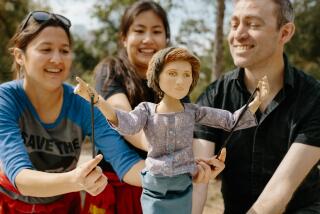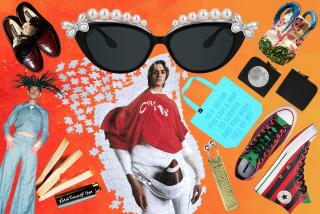Hello Kitty is not a cat, plus more reveals before her L.A. tour
Her expressionless mug has been featured on countless toys, not to mention bowling balls, motor oil, a Fender Strat, a pricey Judith Leiber clutch, sanitary napkins and men’s underwear. She’s inspired a controversial song by Avril Lavigne, works of sculpture by Tom Sachs and a pretty spectacular dress worn by Lady Gaga.
I am talking about Hello Kitty, the adorable cultural force that began life as a character on a coin purse in Japan 1974. Produced by Sanrio, she arrived in the United States two years later. And she’s been a part of global popular culture ever since.
This fall, she is set to take L.A. by storm, with a full-blown retrospective of Kitty art, merch and fashion at the Japanese American National Museum, which opens in mid-October. Two weeks later, the first ever Hello Kitty Con, will be held at the Museum of Contemporary Art.
Christine R. Yano is an anthropologist from the University of Hawaii (and currently a visiting professor at Harvard) who has spent years studying the phenomenon that is Hello Kitty. She is also the author of the book “Pink Globalization: Hello Kitty’s Trek Across the Pacific,” published by Duke University Press last year. She says that Kitty’s unreadable features (she usually doesn’t have a mouth), along with clever merchandising, has helped cultivate the character’s following.
“Hello Kitty works and is successful partly because of the blankness of her design,” Yano says. “People see the possibility of a range of expressions. You can give her a guitar, you can put her on stage, you can portray her as is. That blankness gives her an appeal to so many types of people.”
That also makes her more than just another fabrication of Japan’s culture of cute, known as kawaii.
“She doesn’t have this insipid cuteness,” explain Yano, who is also serving as curator for the Japanese American National Museum’s retrospective. “It’s something clever and creative which contributes to a certain cool factor. For example, take Precious Moments [giftware]. That’s cute. But there’s nothing cool about Precious Moments. Hello Kitty has the potential to be so many other things.”
This year, Kitty turns 40 — and her power as icon and brand shows no sign of abating.
But there’s a lot we don’t know about Hello Kitty. And, Yano, who is currently wading through hundreds of objects for the exhibition at the the Japanese American National Museum (including the famous Gaga dress), gives us the lowdown:
Hello Kitty is not a cat.
You read that right. When Yano was preparing her written texts for the exhibit at the Japanese American National Museum, she says she described Hello Kitty as a cat. “I was corrected — very firmly,” she says. “That’s one correction Sanrio made for my script for the show. Hello Kitty is not a cat. She’s a cartoon character. She is a little girl. She is a friend. But she is not a cat. She’s never depicted on all fours. She walks and sits like a two-legged creature. She does have a pet cat of her own, however, and it’s called Charmmy Kitty.”
I grew up with Hello Kitty everything and all I have to say is, MIND BLOWN.
Hello Kitty is British.
Kitty is actually named Kitty White and she has a full back story. She is a Scorpio. She loves apple pie. And she is the daughter of George and Mary White.
“She has a twin sister,” adds Yano. “She’s a perpetual third-grader. She lives outside of London. I could go on. A lot of people don’t know the story and a lot don’t care. But it’s interesting because Hello Kitty emerged in the 1970s, when the Japanese and Japanese women were into Britain. They loved the idea of Britain. It represented the quintessential idealized childhood, almost like a white picket fence. So the biography was created exactly for the tastes of that time.”
Hello Kitty has special significance to Asian Americans.
Yes, she’s worldwide. But Hello Kitty has had special resonance with Asians who grew up in the United States.
“When Hello Kitty arrived in the U.S. in the mid-1970s, it was a commodity mainly in Asian enclaves: Chinatowns, Japantowns, etc.,” explains Yano. “In talking to Japanese Americans who grew up in the 1970s, they say, ‘That figure means so much to us because she was ours.’ It’s something they saw as an identity marker. This is why the exhibition is being held at the Japanese American National Museum. It’s about reconnecting her to this community. It gives the whole thing a certain poignancy and power.”
“Hello! Exploring the Supercute World of Hello Kitty,” opens Oct. 11 at the Japanese American National Museum, 100 N. Central Ave., downtown Los Angeles, janm.org. Hello Kitty Con runs for four days starting Oct. 30 at the Museum of Contemporary Art, 152 N. Central Ave., downtown Los Angeles, sanrio.com.
Twitter: @cmonstah
More to Read
The biggest entertainment stories
Get our big stories about Hollywood, film, television, music, arts, culture and more right in your inbox as soon as they publish.
You may occasionally receive promotional content from the Los Angeles Times.







